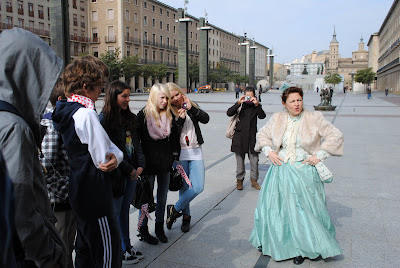The activity has been aimed to 176 pupils (Swedish, English, French, Polish and Spanish) taking part in the different exchanges. The activity has been organized by Gozarte.

La actividad consiste en realizar una gymkana cultural y urbana en la que a través del juego descubran una ciudad inesperada, llena de sorpresas y de rincones atractivos.
The activity consists of doing a cultural and urban gymkana in which they discover an unexpected city, full of surprises and of attractive corners.

En la plaza del Pilar los alumnos se encontrarán Eugenia, una joven de Tarazona venida a Zaragoza durante los meses de la Exposición Hispano-Francesa de 1908 en busca de un novio que la saque de su pertinaz soltería.
In the Square of Pilar the pupils will find Eugenia, a young woman of Tarazona come to Saragossa during the months of the Exhibition Hispanic - French of 1908 in search of a fiancé who gets her out of her pertinacious unmarried state.

El ciego Salvador les espera en la iglesia de Santa Isabel, dispuesto a contarles sus historias de milagros, secuestros, asesinatos... Dentro de su retablo de las maravillas es posible que los alumnos encuentren la pista necesaria para resolver el enigma planteado al principio del juego.
The blind man Salvador is waiting for them in the Saint Isabel church , ready to tell them his stories about miracles, kidnappings, murders... With its altarpiece of the marvels it is possible that the pupils find the necessary clue to solve the puzzle set out at the beginnig of the game.



Delante del teatro romano nos espera Valeria Máxima, toda una señora de su “domus”. Nadie conoce como ella los secretos de Caesaraugusta, así que de su mano los alumnos tienen que convertirse en actores para ayudarle a representar una pequeña historia.
In front of the Roman Theatre, Valeria Máxima is waiting for us, a madam of her "domus". Nobody knows as her the secrets of Caesaraugusta, so through her the pupils have to turn into actors to help her to permorm a little story.




Junto a la iglesia de la Magdalena los alumnos encontrarán a Yusuf, un alfarero musulmán. Lleva un saco lleno de sorpresas, entre otras un puzle mudéjar o los instrumentos necesarios para que cada uno de los participantes escriba su nombre en árabe.
Next to Magdalena Church the pupils will find Yusuf, a Muslim potter. He carries a sack full of surprises, as a Mudejar jigsaw or the necessary instruments so that all of the participants write their name in Arab.



Una vez que cada uno de los grupos ha recorrido las cuatro bases tendrán un mapa completo y un poema, lo que constituye la última parte del juego. En el mapa y el poema están las pistas suficientes para encontrar el lugar en el que el antepasado de estos cuatro personajes, el íbero que tuvo que abandonar la ciudad, escondió el tesoro, que estará dentro de un cofrecillo. Allí les esperará “el guardián del tesoro”, con el que tendrán que superar una última prueba.
Once each of the groups has covered four bases they will have a finished map and a poem, which makes the last part of the game. In the map and the poem we have the necessary clues are to find the place in which the forefather of these four characters, the Iberian who had to leave the city, hid the treasure, which will be inside a little chest. There, “ the guard of the treasure ” is waiting for us, and they will have to overcome a last test.

Ha estado fenomenal!
It's been great!


No hay comentarios:
Publicar un comentario
Nota: solo los miembros de este blog pueden publicar comentarios.